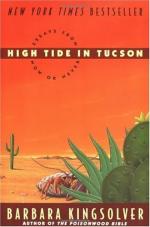
|
| Name: _________________________ | Period: ___________________ |
This test consists of 15 multiple choice questions and 5 short answer questions.
Multiple Choice Questions
1. What evidence does Stephen Jay Gould say George Morton ignored in his measurements?
(a) Evolutionary pressures on early human populations.
(b) Relative skull and body sizes.
(c) Geological origin of specimens.
(d) Cultural influences on bone formations.
2. What predisposes human males to infidelity, according to Barbara Kingsolver?
(a) The desire to gain status.
(b) The desire to spread genes.
(c) The desire to possess females.
(d) The desire to further one's civilization.
3. What did Barbara Kingsolver buy in the unnamed town she found?
(a) Clothing.
(b) A leather purse.
(c) Pottery.
(d) Jewelry.
4. What argument of E.O. Wilson's does book reject?
(a) That people have free will.
(b) That genetics drives all of human existence.
(c) That people are products of their environments.
(d) That morality is an evolutionary construct.
5. What was uncommon about the beach where Barbara Kingsolver collected stones and shells?
(a) Black sand.
(b) Pink sand.
(c) Tall waves.
(d) Unique species of crabs.
6. What did the library recruit Barbara Kingsolver for?
(a) Evaluating the books in the library.
(b) Buying new books for the library.
(c) Raising money for the library.
(d) Organizing the library.
7. For what occasion does Barbara Kingsolver say she bought an expensive, chic outfit?
(a) A writer's meeting.
(b) An award ceremony.
(c) A funeral.
(d) A wedding.
8. How does Barbara Kingsolver describe herself when she was in high school?
(a) A goody-goody.
(b) A socialite.
(c) An egghead.
(d) A nerd.
9. What does Barbara Kingsolver say her school system would not have prepared her for?
(a) Marriage.
(b) A career.
(c) Motherhood.
(d) Literacy.
10. What example does Barbara Kingsolver give us, to justify her characterization of her physique?
(a) She had to shop in the men's section by high school.
(b) She didn't break 100 pounds until the end of high school.
(c) She had to be carried up and down stairs.
(d) She could not break 8 minutes for running a mile.
11. Where did Barbara Kingsolver settle in her travels?
(a) Iceland.
(b) Tenerife.
(c) Sardinia.
(d) Crete.
12. What did Barbara Kingsolver name her creature?
(a) Buster.
(b) Brother.
(c) Bruiser.
(d) Bubba.
13. When did Barbara Kingsolver decide to move to Tucson?
(a) When the race tensions in her area made life dangerous for her.
(b) When the prices for things got too high to afford a good lifestyle with her writing.
(c) When the crime in her area got so bad that she couldn't feel safe.
(d) When the kids in her neighborhood made too much noise for her to write.
14. What does Barbara Kingsolver say worked against her in high school?
(a) Her looks.
(b) Her problems with language comprehension.
(c) Her wardrobe.
(d) Her religion.
15. What does Barbara Kingsolver say the librarian might have seen in her?
(a) Vulnerability.
(b) Potential.
(c) Genius.
(d) Danger.
Short Answer Questions
1. Why does Barbara Kingsolver say she joined the group she joined?
2. What development does Barbara Kingsolver describe as a survival tool people acquired 'in the beginning'?
3. Parents have to strike a balance between boundaries and what, in Barbara Kingsolver's opinion?
4. How did Barbara Kingsolver respond to the demands of fashion as an adult?
5. What resulted from the need to hunt, according to Barbara Kingsolver?
|
This section contains 540 words (approx. 2 pages at 300 words per page) |

|




